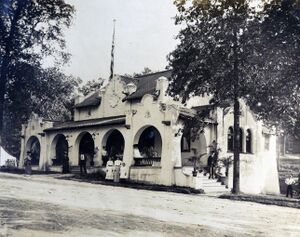New Mexico: Difference between revisions
(Created page with "{{short description|New Mexico State Building}} {{Infobox prepared food | name = New Mexico State Building | image = New Mexico State Building.jpg | image_size = 300px | caption = New Mexico State Building | alternate_name = | country = | creator = | course = | cost = $6,053 ({{Inflation|US|6,053|1904|fmt=eq}}) | admission = | profit = | owner = | main_ingre...") |
No edit summary |
||
| Line 19: | Line 19: | ||
}} | }} | ||
The design of the New Mexico territory building on the [[Plateau of States]] was Spanish Renaissance and the moderate structure measured 40 by 62 feet. | The design of the New Mexico territory building on the [[Plateau of States]] was Spanish Renaissance and the moderate structure measured 40 by 62 feet. | ||
==Etymology== | ==Etymology== | ||
Revision as of 18:11, 9 November 2022
 New Mexico State Building | |
| Construction Cost | $6,053 (equivalent to $182,554 in 2021) |
|---|---|
The design of the New Mexico territory building on the Plateau of States was Spanish Renaissance and the moderate structure measured 40 by 62 feet.
Etymology
Before the Fair
Description
Mission furniture decorated its rooms, and the structure featured the oldest bell in the United States, cast in 1355.
Exhibited in The New Mexico Building, this bell was believed to be hung in the missionary at Cibola, by Friar Juan De Padilla, who accompanied the Coronado expedition. The bell weighs 198 pounds. It was cast in Spain in 1355. In all probability, the bell might contain a sizeable quantity of silver and gold, as in the Middle Ages, people would bless the bell by adding jewels and valuables into the molten metal, before casting.
The superior products shown in New Mexico's agricultural and horticultural exhibits demonstrated that the very best results and most perfect development in fruits and farm products are obtained by irrigation and sunny skies. The fruits, grains, vegetables, and other products of the soil shown were well-received.
New Mexico had exhibits in the Palaces of Education, Mines and Metallurgy (including: coal, iron, zinc, lead, copper, silver, gold, mica, gypsum, salt, sulfur, asbestos, onyx and building stones), Agriculture (irrigation), and Horticulture. The state's principal exhibit was in the Mines and Metallurgy (a working exhibit in exclusive turquoise mining, and lapidary).
Their impressive educational exhibit might have quickened the territory's statehood (In 1912).
